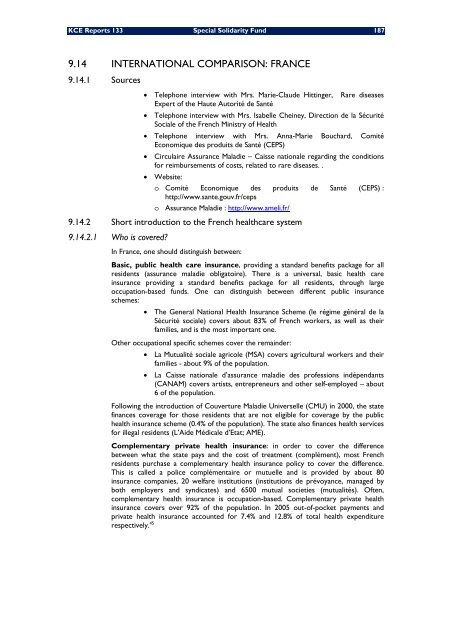Optimalisatie van de werkingsprocessen van het Bijzonder ... - KCE
Optimalisatie van de werkingsprocessen van het Bijzonder ... - KCE
Optimalisatie van de werkingsprocessen van het Bijzonder ... - KCE
You also want an ePaper? Increase the reach of your titles
YUMPU automatically turns print PDFs into web optimized ePapers that Google loves.
<strong>KCE</strong> Reports 133 Special Solidarity Fund 187<br />
9.14 INTERNATIONAL COMPARISON: FRANCE<br />
9.14.1 Sources<br />
• Telephone interview with Mrs. Marie-Clau<strong>de</strong> Hittinger, Rare diseases<br />
Expert of the Haute Autorité <strong>de</strong> Santé<br />
• Telephone interview with Mrs. Isabelle Cheiney, Direction <strong>de</strong> la Sécurité<br />
Sociale of the French Ministry of Health<br />
• Telephone interview with Mrs. Anna-Marie Bouchard, Comité<br />
Economique <strong>de</strong>s produits <strong>de</strong> Santé (CEPS)<br />
• Circulaire Assurance Maladie – Caisse nationale regarding the conditions<br />
for reimbursements of costs, related to rare diseases. .<br />
• Website:<br />
o Comité Economique <strong>de</strong>s produits <strong>de</strong> Santé (CEPS) :<br />
9.14.2<br />
http://www.sante.gouv.fr/ceps<br />
o Assurance Maladie : http://www.ameli.fr/<br />
Short introduction to the French healthcare system<br />
9.14.2.1 Who is covered?<br />
In France, one should distinguish between:<br />
Basic, public health care insurance, providing a standard benefits package for all<br />
resi<strong>de</strong>nts (assurance maladie obligatoire). There is a universal, basic health care<br />
insurance providing a standard benefits package for all resi<strong>de</strong>nts, through large<br />
occupation-based funds. One can distinguish between different public insurance<br />
schemes:<br />
• The General National Health Insurance Scheme (le régime général <strong>de</strong> la<br />
Sécurité sociale) covers about 83% of French workers, as well as their<br />
families, and is the most important one.<br />
Other occupational specific schemes cover the remain<strong>de</strong>r:<br />
• La Mutualité sociale agricole (MSA) covers agricultural workers and their<br />
families - about 9% of the population.<br />
• La Caisse nationale d’assurance maladie <strong>de</strong>s professions indépendants<br />
(CANAM) covers artists, entrepreneurs and other self-employed – about<br />
6 of the population.<br />
Following the introduction of Couverture Maladie Universelle (CMU) in 2000, the state<br />
finances coverage for those resi<strong>de</strong>nts that are not eligible for coverage by the public<br />
health insurance scheme (0.4% of the population). The state also finances health services<br />
for illegal resi<strong>de</strong>nts (L’Ai<strong>de</strong> Médicale d’Etat; AME).<br />
Complementary private health insurance: in or<strong>de</strong>r to cover the difference<br />
between what the state pays and the cost of treatment (complément), most French<br />
resi<strong>de</strong>nts purchase a complementary health insurance policy to cover the difference.<br />
This is called a police complémentaire or mutuelle and is provi<strong>de</strong>d by about 80<br />
insurance companies, 20 welfare institutions (institutions <strong>de</strong> prévoyance, managed by<br />
both employers and syndicates) and 6500 mutual societies (mutualités). Often,<br />
complementary health insurance is occupation-based. Complementary private health<br />
insurance covers over 92% of the population. In 2005 out-of-pocket payments and<br />
private health insurance accounted for 7.4% and 12.8% of total health expenditure<br />
respectively. 45

















